One of the surprises I encountered when reading The Nature of Order was that Christopher Alexander designed a bench at Fort Mason. (He talks about the process of its construction in the third volume of Nature of Order.) So when Agile Open California returned to Fort Mason last year, I made a point to duck out between sessions and find it.
At first glance, the bench was rather disappointing: it’s seen better days, the concrete isn’t the most attractive, and there’s an odd sort of pedestal up front.
This being Christopher Alexander, though, I was willing to believe that there was more than met the eye at first glance, so I spent a bit of time there (and returned a second day), and ended up rather fond of it.
Point one: levels of scale. The concrete is not my favorite material, but it’s not all that there is to the bench: there are tiles on the sides, on the octagon, and in strategic locations on the front on the bench. And the tiles turn out to be rather lovely; I was particularly fond of the fox tile in the center of the front of the bench.
With that in mind, the concrete ends up being a rather fitting backdrop for the tiles to find themselves in. (A bench that was completely worked out at the level of the detail of the tiles would be a different work indeed!) Also, while I don’t know what constraints in terms of time and money Alexander had to work with, in general you have to make tradeoffs as to where you spend your efforts; rather than treating everything uniformly, he made sure that the tiles were special, while leaving their surroundings perfectly functional but requiring much less work.
Point two: this isn’t a work of art to be admired, it’s a bench to be used. The proportions of the bench seemed a little odd when I was looking at it, but it was really quite comfortable to sit on. And flexible, too: you can sit on the first row, you can sit on the second row, a single person wouldn’t feel overwhelmed by it but I imagine you could get as many as 20 people sitting around there if you really wanted to. (To be honest, I’m not sure why you’d want to, but still.)
And then there’s the odd octagonal pedestal at front. When I first saw it, I was nonplussed: I was willing to believe that the area in front of the bench would have felt a bit odd without something there, but I wasn’t completely convinced by the pedestal as a solution to the problem. When I came back the second day (which is when all of these pictures were taken), however, a man was there fishing, and the pedestal was in just the right place and at just the right height for him to keep his gear. So, in fact, the pedestal turned out to work very well in the living context of people actually using this area, standing closer to the water. (The trash can, in contrast, just looked ugly there.)
Point three: the setting. As Alexander repeatedly points out, you can’t consider a construction in isolation, you have to consider the construction in context. And the context for this bench is rather remarkable: you have rather steep hills covered with trees behind you and to your right, you have the Fort Mason buildings to your left, and in front of you you have a gorgeous view of the San Francisco Bay, with Alcatraz and Angel Island in the distance.
So it’s a funny sized area, far too small to place an actual building, but exactly the sort of secluded nook where people might want to hide out, relax, chat, and drink in the scenery. And a traditional park bench wouldn’t work nearly as well in the space: the space is large enough that a traditional bench would be so small as to feel at sea, and a traditional bench would also direct your view exclusively across the bay (which, while the most scenic view, is far from the only view of interest). And the size of the hills behind and to the right of the bench demand a certain response; the substantial nature of the bench and its cinderblock construction make it just the sort of object that doesn’t get overwhelmed by that context.
When all is said and done, I ended up quite fond of the bench. I just wish I’d had more time to spend there, instead of having to steal time between sessions. Agile Open California will be back at Fort Mason this year; maybe I’ll run a session at the bench instead of in the regular meeting rooms, weather permitting?
Post Revisions:
This post has not been revised since publication.
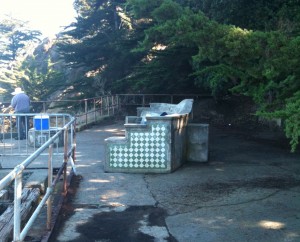
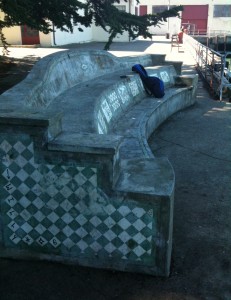
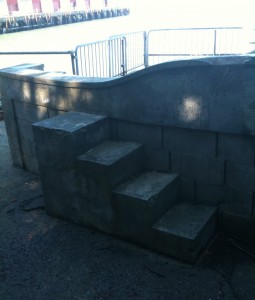
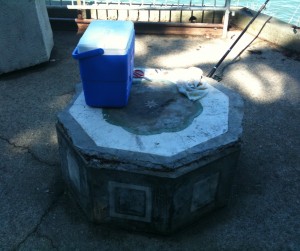
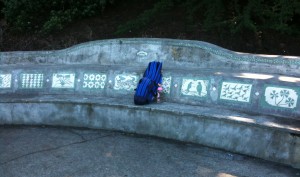
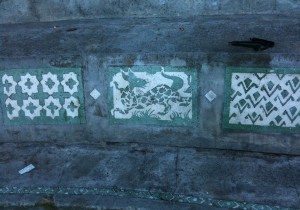
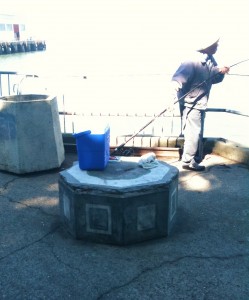

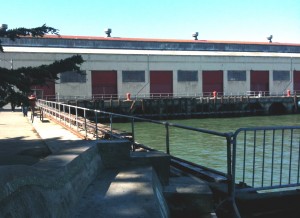
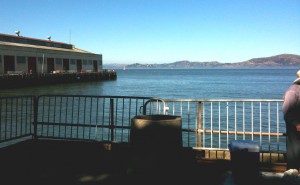

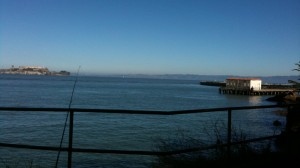

 Posts
Posts
[…] christopher alexander’s fort mason bench | malvasia bianca “As Alexander repeatedly points out, you can’t consider a construction in isolation, you have to consider the construction in context. And the context for this bench is rather remarkable: you have rather steep hills covered with trees behind you and to your right, you have the Fort Mason buildings to your left, and in front of you you have a gorgeous view of the San Francisco Bay, with Alcatraz and Angel Island in the distance.” (tags: Alexandrianism design-patterns pattern-language architecture public-space design social-dynamics) […]
4/25/2010 @ 10:04 pm
[…] looking at the bench last year, I decided that I had to hold a session there unless it was pouring: its presence is too much of a […]
10/11/2010 @ 9:38 pm